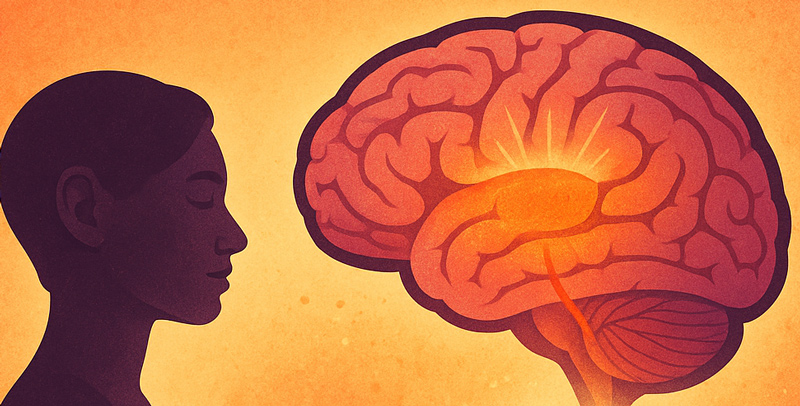
Between Wake and Sleep: The Mysterious Territory of Savasana
May 8, 2025
Gratitude for Self: It Ain’t Easy (But So Worthwhile!)
October 18, 2025In our household, September is a “heady” month. This year, two of our kids started at new schools, and our wall calendar is crammed with events. Even with reminders, there is still a lot to hold in our heads. On top of that, we try to reflect on shifting circumstances and adjust our plans. When I pause, I notice how noisy my headspace has become.
Although thoughts can feel immaterial, as if belonging to a disembodied self, our mental states are inseparable from the realities of our bodies. Every mental event both needs energy and leaves metabolic waste in its wake. The noisier the traffic in our heads, the more energy is consumed, leading to more waste buildup and greater mental fatigue.
But not all mental events put the same load on our resources. When we simply perceive our environment without added interpretation, or act through well-practiced movement pathways, we minimize cognitive load. These cognitive events may occur outside awareness, below the threshold of consciousness. On the other hand, metacognition is our ability to reflect on our inner lives: our thoughts, feelings and actions. It is a remarkable skill, but it is more complex than direct perception and action, and therefore requires more mental resources.
Now, when our mind is busy, we hold a higher number of thoughts, feelings, and actions in awareness in a given moment. These are held in our working memory, which sustains the “things” which are readily available in consciousness. The more we hold in working memory, the more we need to manage the relationship between competing mental events. “What should I be paying attention to now? What am I forgetting?” With more time and energy invested in metacognition, less time is spent actually tending to the decisions and actions needed to move through our lives. It’s that feeling of being caught in a spinning wheel: in motion, yes… but not getting anywhere.
Remember, all mental events require energy, thus have the potential to create fatigue. But when we’re not able to feel the benefits of our mental efforts, because we’re thinking about thinking, then the costs of thinking grow. When mental fatigue sets in, emotions can skew towards negativity, habits take over, and our thoughts can get more rigid or extreme. And while a “mind over matter” narrative can help push us beyond our limits, mental fatigue may actually be a preservation mechanism, reminding us to pause and restore.
When facing noisy traffic in your head and mental fatigue, how does yoga help? Think of the guidance you follow when first settling onto your mat: “turn your attention inward”. By default, you may be caught in the stream of inner commentary, like “Did I put my phone on silent?” or “I forgot to drop off that package today!”. However, that internal mental chatter still involves a lot of brain power, including language networks and the self-referential default mode network.
Instead of running with our thoughts, the key action of introspective awareness in yoga is to bring our attention to fundamental embodied sensations that need no further elaboration: the breath, the support of the ground, or the simple rhythm of movement. Attending to somatic sensations still takes mental energy, but it spares us the fragmentation of juggling working memory tasks and constantly switching focus between them. It also provides us with a sense of agency, that we are accomplishing something, instead of just thinking about it. Therefore, Hatha yoga is especially effective for a busy mind because the salience of movement control shifts our attention from noisy mental activity to a more stable, unforced stream of consciousness.
There are a few potential benefits to coalescing our focus in this way. Firstly, it gives us relief from the effort of carrying an overloaded mind. As cycles of ruminant thought are interrupted, working memory clears. Mental chatter quiets as we shift our attention to simpler anchors. Even the mental effort of tracking time can dissolve, entrusted to the facilitator of your experience. A skilled teacher will also be practicing this attunement, which helps sustain an energetic equilibrium in the room. This can give us a chance to get ahead of the natural metabolism of mental waste and refresh our minds for the day ahead.
Secondly, having a sense of agency over our mental and physical state is empowering. Understanding our bodies and minds, connecting with the reality of embodiment, can help relieve the stress and anxiety that arise from uncertainty.
Thirdly, although I haven’t explicitly said that yoga is a mindfulness practice, this is in fact what I’ve been describing: the act of attending to present moment experience without judgement. This tool can help us learn to decenter from the stress of an overloaded mind and may give us a renewed perspective on how we relate to our experiences and responsibilities. This is a powerful, longer-term effect of the practice, as we improve our ability to cope with and reframe the things on our mind.
Of course, interruptions arise, both from within and without. But we return, again and again, to a more grounded, mindful state. And why bother? We can’t always attend to present-moment experience: reflection, planning, and other forms of higher-order thought are essential. However, they unfold more easily when the mind is replenished and at ease. On a physiological level, without restorative practices, chronic low-grade neuroinflammation and excitotoxic buildup from overactive neural firing can impair our minds and accelerate cognitive decline. A yoga practice helps us sustain a healthy mind for the long run.
Now, after writing this, perhaps I’ll do a few sun salutations :)
Karen Andersen
BSc. Behavioural Neuroscience, E-RYT 500, YACEP





